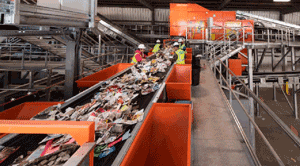Kansas-based Hamm Inc. will process residential single-stream material.
 Spartanburg, South Carolina-based Stadler America LLC has announced its German parent company Stadler Anlagenbau has installed its first single-stream sorting and recycling plant in North America at Hamm Inc. in Lawrence, Kansas.
Spartanburg, South Carolina-based Stadler America LLC has announced its German parent company Stadler Anlagenbau has installed its first single-stream sorting and recycling plant in North America at Hamm Inc. in Lawrence, Kansas.
The plant sorts residential single stream material, consisting of paper and old corrugated containers (OCC), PET (polyethylene terephthalate) and mixed plastics, glass, ferrous and nonferrous materials. The system has a capacity of 10 metric tons per hour. An extension to a 20 metric tons per hour capacity is planned.
The heart of the single-stream line is the large-capacity Stadler ballistic separator STT5000/101 for the sorting of 2D (paper), 3D (containers) and fines. Other key components of the plant are a DB Technologies OCC screen; glass breaker and windshifter; a Steinert optical sorter; magnet and eddy current separator; and a Joest flip-flop screen.
In 2013, the city of Lawrence established the single-stream collection system to reduce the landfilling of recyclables and rewarded Hamm with the contract. Stadler's planning period started in 2014, and the system has been installed in the same year. The final startup took place in 2015.
Hamm Inc. is headquartered in Perry, Kansas. Its portfolio of services in the region includes highway construction, mining and waste disposal services, including landfills, transfer stations and roll-off services.
Stadler America LLC is the US subsidiary of Stadler Anlagenbau in Germany. Stadler is a supplier of complete turnkey sorting and recycling plants for the waste management industry, with 250-plus material recovery facilities (MRFs) in operation globally.
Stadler says it is the originator of the ballistic separator (2D/3D screen), and has sold more than 700 units worldwide, with 20 units in North America.